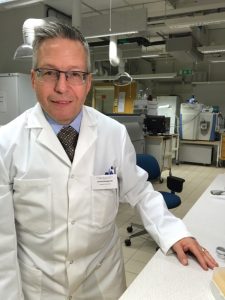We’re pleased to share a new publication by Jonas Bergquist, MD, PhD, and colleagues: Targeted analysis of seven selected tryptophan-melatonin metabolites: Simultaneous quantification of plasma analytes using fast and sensitive UHPLC-MS/MS.
The Heart of the Matter
- The ME/CFS Collaborative Center at Uppsala published a paper on their new methodology: ultra-high performance liquid chromatography-tandem mass spectrometry (UHPLC-MS/MS).
- This methodology can separate and quantify tryptophan metabolites with good precision and in under ten minutes.
- Tryptophan metabolites may play a role in two hallmark symptoms of ME/CFS, sleep disturbance and brain fog, indicating UHPLC-MS/MS could be a particularly useful tool in future research into the disease.
Targeted analysis of seven selected tryptophan-melatonin metabolites: Simultaneous quantification of plasma analytes using fast and sensitive UHPLC-MS/MS
 This new method developed by the team allows researchers to simultaneously separate and quantify tryptophan metabolites, including serotonin, N-acetylserotonin, tryptamine, 6-sulfatoxymelatonin, hydroxymelatonin, melatonin, and N-acetyltryptamine. These metabolites are important in the context of ME/CFS because they have implications for hallmark symptoms of the disease: sleep disturbance and brain fog.
This new method developed by the team allows researchers to simultaneously separate and quantify tryptophan metabolites, including serotonin, N-acetylserotonin, tryptamine, 6-sulfatoxymelatonin, hydroxymelatonin, melatonin, and N-acetyltryptamine. These metabolites are important in the context of ME/CFS because they have implications for hallmark symptoms of the disease: sleep disturbance and brain fog.
Using UHPLC-MS/MS, intraday and interday precision was below 15% for all metabolites—except for N-acetyltryptamine—which meets accuracy criteria. Intraday precision measures how consistent the results are when the same sample is evaluated multiple times in the same day. Interday precision measures the consistency across different days. A value under 15% means that the standard deviation of the measurements is no more than 15% and this is generally accepted as an appropriate criteria for being considered an accurate analysis. Importantly, the UHPLC-MS/MS methodology can be conducted in less than ten minutes, which increases its translatability to everyday clinical and research efforts.
Read the full article in Journal of Chromatography B.
Accelerate Research for ME/CFS and Long COVID
Through Research Participation
OMF StudyME is a free global recruitment tool that connects individuals interested in participating in research studies with the researchers conducting them. If you haven’t already done so, by signing up, you have the power to help researchers find answers for ME/CFS and Long COVID. The process is easy and takes less than five minutes.



